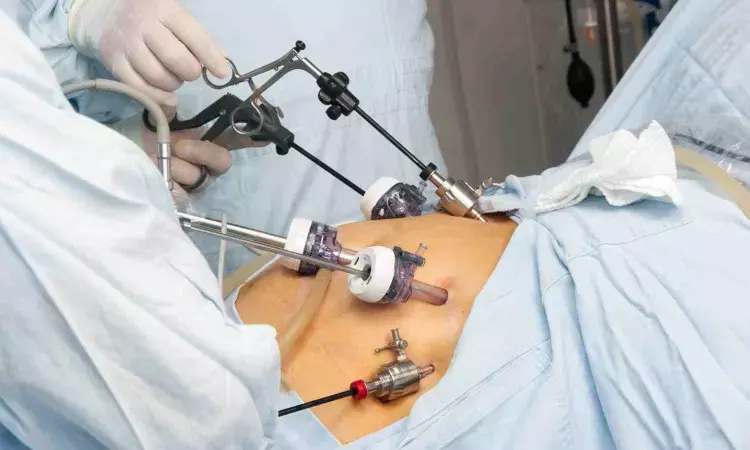- Home
- Medical news & Guidelines
- Anesthesiology
- Cardiology and CTVS
- Critical Care
- Dentistry
- Dermatology
- Diabetes and Endocrinology
- ENT
- Gastroenterology
- Medicine
- Nephrology
- Neurology
- Obstretics-Gynaecology
- Oncology
- Ophthalmology
- Orthopaedics
- Pediatrics-Neonatology
- Psychiatry
- Pulmonology
- Radiology
- Surgery
- Urology
- Laboratory Medicine
- Diet
- Nursing
- Paramedical
- Physiotherapy
- Health news
- Fact Check
- Bone Health Fact Check
- Brain Health Fact Check
- Cancer Related Fact Check
- Child Care Fact Check
- Dental and oral health fact check
- Diabetes and metabolic health fact check
- Diet and Nutrition Fact Check
- Eye and ENT Care Fact Check
- Fitness fact check
- Gut health fact check
- Heart health fact check
- Kidney health fact check
- Medical education fact check
- Men's health fact check
- Respiratory fact check
- Skin and hair care fact check
- Vaccine and Immunization fact check
- Women's health fact check
- AYUSH
- State News
- Andaman and Nicobar Islands
- Andhra Pradesh
- Arunachal Pradesh
- Assam
- Bihar
- Chandigarh
- Chattisgarh
- Dadra and Nagar Haveli
- Daman and Diu
- Delhi
- Goa
- Gujarat
- Haryana
- Himachal Pradesh
- Jammu & Kashmir
- Jharkhand
- Karnataka
- Kerala
- Ladakh
- Lakshadweep
- Madhya Pradesh
- Maharashtra
- Manipur
- Meghalaya
- Mizoram
- Nagaland
- Odisha
- Puducherry
- Punjab
- Rajasthan
- Sikkim
- Tamil Nadu
- Telangana
- Tripura
- Uttar Pradesh
- Uttrakhand
- West Bengal
- Medical Education
- Industry
Pioneering Pain Control: Which Technique Wins? TAP vs. Intrathecal Hydromorphone in the OR for abdominal surgery, study finds

Recent article compares two different pain management techniques used after upper abdominal surgeries. One is called intrathecal hydromorphone (ITH), where a pain medication is injected directly into the spinal fluid. The other is called a transversus abdominis plane (TAP) block, where numbing medicine is injected into the abdominal wall. The researchers found that patients who received the ITH technique had less severe pain when moving around on the first day after surgery, compared to those who got the TAP block. This suggests the ITH was better at controlling pain during movement. However, the TAP block had some advantages. Patients who got the TAP block had less itching as a side effect, and their bowels started working again sooner after surgery.
The amount of pain medication needed was also a bit lower in the TAP block group. Overall, the study suggests that ITH may provide better pain relief, especially when patients are moving around, compared to the TAP block. But the TAP block has some benefits too, like less itching and faster recovery of bowel function. The researchers think the reason for these differences is that the ITH provides longer-lasting pain relief, while the TAP block is more focused on the abdominal area. Since upper abdominal surgeries tend to be very painful, the longer-lasting pain relief from ITH may be more helpful. However, this was a retrospective study, which means the researchers looked back at medical records rather than doing a controlled experiment. So there could be other factors that influenced the results that the researchers didn't account for. The authors recommend that doctors consider the type of surgery when choosing between ITH and TAP block for pain management. For open abdominal surgeries, ITH may be the better choice. But for less invasive laparoscopic surgeries, the TAP block may be preferable due to its benefits for recovering bowel function. Overall, this study provides helpful information to doctors on the pros and cons of these two pain management techniques for patients undergoing upper abdominal surgery. But more research, especially controlled studies, is still needed to fully understand which approach works best.
Key points –
- Intrathecal hydromorphone and transversus abdominis plane (TAP) block are commonly used analgesic techniques for upper abdominal surgeries, with intrathecal opioid injection providing prolonged analgesia with a lower dose compared to intravenous administration.
- A retrospective study aimed to compare the analgesic efficacy of intrathecal hydromorphone and TAP block in upper abdominal surgeries by assessing the primary outcome of moderate-to-severe pain during movement at 24 hours postoperatively.
- Propensity score-matching (PSM) was used to minimize baseline differences and reduce potential confounding in outcome comparisons, with 91 matched patients in each group showing evenly distributed baseline characteristics.
- The study found that intrathecal hydromorphone was superior to TAP block in reducing moderate-to-severe pain during movement on the first postoperative day after upper abdominal surgery, with a lower incidence of pain and higher comfort levels in the intrathecal group.
- Patients receiving intrathecal hydromorphone required less opioid medication, reported higher satisfaction levels, but had a higher incidence of pruritus and delayed first flatus compared to the TAP block group.
- Future research should focus on integrating the benefits of intrathecal hydromorphone into multimodal analgesia for upper abdominal surgeries and conducting well-designed randomized controlled trials to compare the most effective analgesic technique for this surgical population.
Reference –
Yue-Xin Huang et al. (2025). Intrathecal Hydromorphone Vs. Transversus Abdominis Plane Block For Upper Abdominal Surgery: A Propensity Score-Matching Study. *BMC Anesthesiology*, 25. https://doi.org/10.1186/s12871-025-03107-w.
MBBS, MD (Anaesthesiology), FNB (Cardiac Anaesthesiology)
Dr Monish Raut is a practicing Cardiac Anesthesiologist. He completed his MBBS at Government Medical College, Nagpur, and pursued his MD in Anesthesiology at BJ Medical College, Pune. Further specializing in Cardiac Anesthesiology, Dr Raut earned his FNB in Cardiac Anesthesiology from Sir Ganga Ram Hospital, Delhi.


